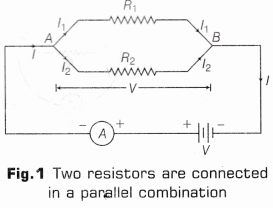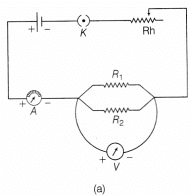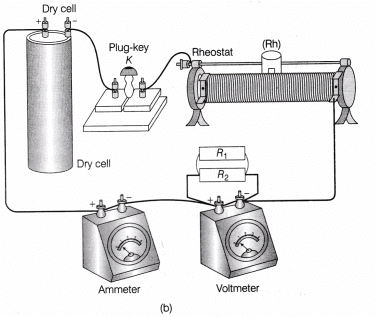Lab Manual: Resistors in Parallel - Class 10 PDF Download
Objective
To determine the equivalent resistance of two resistors, when connected in parallel combination
Materials Required
Two standard resistance coils (or resistors), ammeter (0-1.5 A), voltmeter (0-1.5 V), one-way plug key, a low resistance rheostat, connecting wires, a piece of sand paper and cell or battery eliminator.
Theory/ Principle
An arrangement of resistors in which number of resistors are connected between two common points in such a way that the potential difference across each resistor is equal to the applied voltage is called parallel combination of resistances.

As shown in Fig. 1, two resistors of resistances R1 and R2 are connected between two points A and B in parallel combination. Let the potential difference applied by the DC source to this combination be V.
Let I1 and I2 be the currents measured by an ammeter, connected in series with each resistor R1 and R2 respectively, then
I = I1 + I2 …….(i)
According to Ohm’s law,
I1 = V/R1 and I2 = V/R2 .......(ii)
If Rp is the equivalent resistance of the given parallel combination, having the same potential difference as the applied potential, then
I = V/Rp ......(iii)
From Eqs. (i), (ii) and (iii), we get
or
or
Therefore, when number of resistances are connected in a parallel combination, the reciprocal of the equivalent resistance is equal to the sum of the reciprocals of the individual resistances.
Procedure
- Note down the least count and zero error (if any) of the given ammeter and voltmeter.
- Clean the ends of connecting wires using sand paper.
- Find the values of two given resistances R1 and R2 by the procedure given in Experiment 5

- Connect the given resistors in parallel combination between the two terminals of the voltmeter (as shown in Fig. 3).
 Fig. 3 (a) Circuit diagram for resistors in parallel
Fig. 3 (a) Circuit diagram for resistors in parallel
 Fig. 3 (b) Block diagram for resistors in parallel
Fig. 3 (b) Block diagram for resistors in parallel
- Put the plug in the key and take the readings of ammeter and voltmeter (as done in Experiment 5).
- Repeat the step 5 three times by changing the position of the sliding contact of the rheostat (as done in Experiment 5).
- Tabulate the readings and find the ratio of V and I. It will give the equivalent resistance of the combination.
Observation
- Least count of ammeter = ………… A
- Zero error of ammeter = ………….. A
- Least count of voltmeter = ………. V
- Zero error of voltmeter = …………. V
- Zero correction in ammeter reading = ……….. A
- Zero correction in voltmeter reading = ………… V

Calculations
- Mean value of R1 = ……….. Ω
- Mean value of R2 = ………. Ω
Equivalent value of parallel combination,- By calculations,

- By experiment, Rp = …………. Ω
- By calculations,
Result
- The equivalent resistance of parallel combination, Rp = ………….. Ω
- There is close agreement between the calculated value and the value obtained by the experiment. Hence, 1/Rp = 1/R1 + 1/R2 is verified.
Percentage Error
It shows that percentage error is within the experimental error.
Precautions
- It is to be properly checked that ammeter is connected in series and voltmeter is connected in parallel.
- The connecting wires should be thick and must have tight connection at joints.
- The ends of connecting wires should be cleaned properly using sand paper.
- The ammeter and voltmeter must be of proper range and of less least count.
- Current should be passed for very short time, otherwise heating effect can change the actual result.
Sources of Error
- Reading error may be possible while observing the pointer of ammeter and voltmeter.
- Thick connecting wires may not be available at the time of performing the experiment.
- Area of cross-section of resistance may not be uniform across the length of wire.
- The high resistance rheostat may be used.
- Current may be allowed for longer period.
- The terminal screws of the instruments may not be tightened properly.















